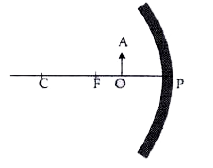Draw a ray diagram showing the formation of image of a point object by a plane mirror.
To draw a ray diagram showing the formation of an image of a point object by a plane mirror, follow these steps:
1. Draw the Plane Mirror: Start by drawing a vertical line to represent the plane mirror. Label it as "Plane Mirror".
2. Draw the Point Object: On one side of the mirror, draw a small arrow pointing upwards to represent the point object. Label this arrow as "Point Object (O)".
3. Draw the Incident Rays: From the point object, draw two straight lines (rays) heading towards the mirror.
- The first ray should be drawn at an angle towards the mirror and should strike the mirror at a point. Label this ray as "Incident Ray 1".
- The second ray should be drawn parallel to the first ray and should also strike the mirror at a different point. Label this ray as "Incident Ray 2".
4. Draw the Reflected Rays:
- For the first incident ray, draw a line reflecting off the mirror at the same angle it struck the mirror. Label this as "Reflected Ray 1".
- For the second incident ray, draw a line reflecting off the mirror in the same manner. Label this as "Reflected Ray 2".
5. Extend the Reflected Rays: Extend the reflected rays backward (behind the mirror) using dashed lines. This is where the image will appear to be formed.
6. Locate the Image: The point where the dashed lines of the reflected rays intersect is where the image of the point object is formed. Draw a small arrow pointing upwards at this intersection point and label it as "Image (I)".
7. Label the Distances: Optionally, you can label the distances from the object to the mirror and from the image to the mirror to show that they are equal.
Final Diagram:
Your final diagram should show a plane mirror with a point object on one side, two incident rays striking the mirror, and two reflected rays extending back to form an image behind the mirror.
- The first ray should be drawn at an angle towards the mirror and should strike the mirror at a point. Label this ray as "Incident Ray 1".
- The second ray should be drawn parallel to the first ray and should also strike the mirror at a different point. Label this ray as "Incident Ray 2".
- For the first incident ray, draw a line reflecting off the mirror at the same angle it struck the mirror. Label this as "Reflected Ray 1".
- For the second incident ray, draw a line reflecting off the mirror in the same manner. Label this as "Reflected Ray 2".
Your final diagram should show a plane mirror with a point object on one side, two incident rays striking the mirror, and two reflected rays extending back to form an image behind the mirror.
Topper's Solved these Questions
- LIGHT ENERGYBOOK - ICSECHAPTER - LIGHT ENERGYEXERCISE - QUESTIONS
6 Videos
- LIGHT ENERGYBOOK - ICSECHAPTER - LIGHT ENERGYEXERCISE - QUESTIONS (Write T for True and F for False)
5 Videos
- LIGHT ENERGYBOOK - ICSECHAPTER - LIGHT ENERGYEXERCISE - TEST YOURSELF (SELECT THE CORRECT)
10 Videos
- HEATBOOK - ICSECHAPTER - HEATEXERCISE - EXERCISE (PICTURE)
10 Videos
- MODEL TEST PAPER 1BOOK - ICSECHAPTER - MODEL TEST PAPER 1EXERCISE - SECTION II
43 Videos
Similar Questions
(a) Draw the ray diagram for the formation of image of an object by a convex mirror and use it (along with the sign convention) to derive the mirror formula.
(b) Use the mirror formula to show that for an object, kept between the pole and focus of a concave mirror the image appears to be formed behind the mirror.
View SolutionA linear object is placed on the axis of a lens. An image is formed by refraction in the lens. For all positions of the object on the axis of the lens, the positions of the image are always between the lens and the object.
(i) Name the lens.
(ii) Draw a ray diagram to show the formation of the image of an object placed in front of the lens at any position of your choice except infinity.
View SolutionDraw diagrams to show the formation of beats?
View SolutionDraw a simple ray diagram showing the formation of a primary rainbow.
View SolutionDraw a ray diagram to show the formation of image by a concave mirror for an object placed between its pole and focus. State three characteristics of the image.

View SolutionDraw a ray diagram to show the formation of image by a concave mirror for an object beyond its centre of curvature. State three characteristics of the image.
View Solution
Draw a ray diagram to show the formation of the image as specified in the part a.
View SolutionAn object is viewed through a glass prism with its vertex pointing upwards. Draw a ray diagram to show the formation of its image as seen by the observer.
View SolutionThe image of a real object formed by a plane mirror is -
View SolutionBy drawing a neat diagram show the formation of an image in a concave mirror when the object is between the pole and the principal focus of the mirror. State the characteristics of the image.
View Solution
